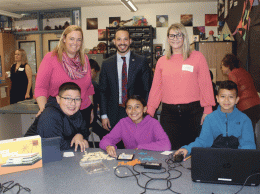Dubroff: Education revolution necessary for students to compete
Lynda Weinman is on a mission to put some STEAM into STEM. Along the way, she’d like to overhaul the way we think about education.
In an impassioned talk to 300 community leaders at a Girls Inc. lunch on Oct. 15, Weinman, the founder of Lynda.com, said she wasn’t buying into what she called the “trendy buzzword” of science, technology, engineering and math, particularly when it comes to girls.
Echoing a view that’s gaining wider credence among educators and parents, she dismissed the STEM movement as the latest fad in a system that continues to fall short of the mark in preparing students for a globalized and more competitive workplace.
Instead, she said in her keynote speech, that at a minimum, the education establishment should add an “A” for “arts” to the formula and transform STEM into STEAM. She said a gift for creative thinking and design contributed heavily to her success with Lynda.com, which was sold to LinkedIn for $1.5 billion earlier this year.
“Contrary to belief, I did not have an Ivy League education. I was not a STEM graduate,” she said. “I was the product of a divorce who struggled with self-esteem and was left alone on afternoons,” she said.
She added that her husband, business partner and kindred spirit, Bruce Heavin, also was not a high-achieving student from an elite college. Instead, she recalled, he struggled with learning disabilities and Asberger syndrome.
She decried what she called the “relentless pursuit of test scores” that puts tremendous pressure on students, particularly girls. Teaching to the test is a mistake that robs students of the pleasure of idea discovery.
Instead, she advocated for a totally overhauled education system that enables students to pursue “fulfillment and a sense of purpose.”
In creating Lynda.com, she said, she created a learning system that better met the needs of the workplace rather than traditional studies. Lynda.com’s video instructional tools taught a generation of professionals and amateurs about technology and graphic design at their own pace, at a reasonable price and on their own time.
She said she designed Lynda.com to be a learning eco-system that specifically “doesn’t teach to the test” and doesn’t measure everyone to its same standard.
Moreover, she said the sale of Lynda.com was not as much about cashing out as it was about expanding the platform’s footprint globally. When LinkedIn made an unsolicited offer, she said, what she saw was the chance for its 400 million users to take advantage of the tools she created.
The path to including more women in tech lies through the incorporation of design and softer skills such as communication, working in groups and critical thinking, she said.
“Apple and Tesla are design-based projects,” she said, adding that when Dos Pueblos’ widely heralded engineering academy added a kinetic sculpture competition to its curriculum, participation of female students soared to 50 percent of the class.
Weinman, a member of our Business Hall of Fame, is on to something. Teaching to the test separates good test takers from poor ones and STEM alone isn’t likely to raise college graduation rates, which have been stuck in neutral for decades.
It also doesn’t come close to capturing the inventive spirit of American entrepreneurship.
That belongs to mavericks like the Wright Brothers, high school dropouts whose ability to solve problems led them to create a flying machine that broke barriers deemed impossible to overcome. And to independent thinkers like Lynda Weinman.
• Reach Editor Henry Dubroff at hdubroff@pacbiztimes.com.











